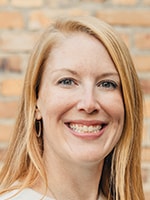Charna Albert
October 2022—Influenza incidence and what it will mean for testing in this respiratory virus season is a wild card, as is how SARS-CoV-2 will evolve. In early September, SARS-CoV-2 prevalence was declining in parts of the United States. “And if you believe in the theory of viral interference,” says Michelle Tabb, PhD, chief scientific officer at DiaSorin Molecular, “it’s leaving the door wide open right now for something else to step in. We’ll see if that’s RSV, or flu A, or if it’s a new COVID variant.”

Dr. Tabb
Australia saw an early peak in influenza and the highest it has seen in about half a decade, simultaneous with COVID, says David Persing, MD, PhD, chief scientific officer at Cepheid. Public health advisors worry the same could happen in the Northern Hemisphere. “The concern is we’re going to have a surge in influenza and an ongoing level of COVID activity that will combine to create a pretty consequential respiratory season,” Dr. Persing says. Furthermore, with fewer exposed to influenza over the past two years, “the lack of natural immunity could create a condition in which we have more severe cases, or more cases overall, and that’s what everybody is afraid of.”
Australia’s statistics, while concerning, could reflect some amount of ascertainment bias, says Daniel Rhoads, MD, assistant professor and section head of microbiology at the Cleveland Clinic. “People are getting tested more now than they did pre-COVID when they have a respiratory virus,” he says. “So I think we’re going to detect more influenza, and we have to keep in mind that increased testing is going to lead to increased detection.”
What impact flu will have on the laboratory this season is uncertain, he says, because how many of those who become ill and don’t need hospitalization will seek a laboratory diagnosis for their respiratory disease is “an unknown variable.”

Dr. Persing
Nevertheless, he’s more confident about the upcoming respiratory season than he was in the previous pandemic years, thanks to experience. “We’ve learned a lot through the school of hard knocks,” he says. “And supply chain is in a much better place than it was a couple years ago.” Though there’s still the risk of severe outbreak in the vein of omicron this winter, “the challenge then isn’t so much the reagents. It’s having enough healthy people to take care of all the patients and do all the testing. So I think that remains a potential point of failure.”
Dr. Rhoads and others in late summer shared their predictions and plans for the upcoming season.
The Cleveland Clinic’s laboratory is implementing a testing strategy, honed over the past few pandemic years, that reflects the need to differentiate patients’ respiratory symptoms.
In the 2020–2021 flu season, Dr. Rhoads says, the Cleveland Clinic did not test adults for influenza routinely because of acutely limited resources. “We continued to test symptomatic children throughout that winter and essentially didn’t detect any influenza.” The following winter, he says, influenza A did circulate. “Interestingly, it was circulating and then omicron emerged. And during peak omicron, influenza dropped, and then as it waned, influenza came back. But we saw only H3N2 last winter, whereas typically we’ll see two influenza strains circulate sequentially in winter.” It may be that SARS-CoV-2 outcompeted flu, “but there are different opinions and thoughts,” he says. “I don’t know that we have good answers.”
This year at the Cleveland Clinic, he says, anyone who is symptomatic will receive multiplex testing for SARS-CoV-2 and influenza. “We will do stat testing if a patient is coming through the emergency department and might need hospitalization. We use the Cepheid GeneXpert platform for that.” Those platforms, he says, are installed in the main campus laboratory and distributed throughout the region at the Cleveland Clinic’s local hospitals.
For routine outpatient testing, they will run the Roche Cobas SARS-CoV-2 and influenza A/B test on the Cobas 8800 platform, which is performed as consolidated testing at the main campus. “And then for children, especially young children, we typically test for RSV in addition to influenza and SARS-CoV-2.” For routine turnaround time, that testing is performed on Hologic’s Panther using the Panther Fusion Flu A/B/RSV assay, which is RT-PCR, and the Aptima SARS-CoV-2 assay, which uses Hologic’s transcription-mediated amplification technology. “So those are our go-to workflows,” he says. Broad respiratory panel testing with the BioMérieux BioFire RP2.1 or Luminex NxTAG is used sparingly, he adds, typically on immunocompromised inpatients.
The Cleveland Clinic performed rapid molecular point-of-care testing for influenza on the Roche Cobas Liat (which can test for flu A/B and SARS-CoV-2 simultaneously, or A/B and RSV) in years past but stopped at the beginning of the pandemic, Dr. Rhoads says, and as of now has no plan to reinstate it. “We keep talking about it,” he says, “but there’s a few challenges with point-of-care testing in 2022. One is that it takes space and time to do the testing and we all know that staffing, in the laboratory but also at the front lines where people are seeing patients in primary care, is challenging.”

Dr. Rhoads
In addition, he says, some of the POC platforms are capable of testing for only one virus at a time, “or at least not all the viruses at one time. So now in addition to needing time, you sometimes need more than one sample, or more than one instrument. Or if the point-of-care testing is antigen testing and you don’t believe the result, if it doesn’t fit with the clinical syndrome, then maybe you’re collecting another sample and sending it for a nucleic acid amplification test. So where we’ve landed and what we’re planning for this season is to do lab-based testing.” The stat testing is done on site or at a local laboratory with a PCR platform, he says, and the routine outpatient testing in the main campus laboratory has a turnaround time of about a day.
New this year for the Cleveland Clinic is the SelfCheck Cobas SARS-CoV-2 + Flu assay, for which the laboratory received an EUA from the Food and Drug Administration. The test, which detects influenza A and B in addition to SARS-CoV-2, pairs an unsupervised, self-collected anterior nasal swab specimen with the Roche Cobas 8800 workflow, Dr. Rhoads says. Patients collect their specimen at home and deposit it in one of many drop boxes located throughout the Cleveland Clinic system. “It’s convenient for us in the laboratory because we can use it with our high-throughput testing systems.”
The self-check option benefits telehealth patients, he says, who can receive a prescription to pick up a collection kit from their local Cleveland Clinic pharmacy during a remote visit rather than have to schedule an in-person clinic visit. And with the self-collected specimen the health care system requires less “swabbing capacity,” he says. “Instead of having a swabbing tent or a drive-through collection, we use the self-check process,” averting what can become a specimen collection “pinch point.” Though the SelfCheck test for SARS-CoV-2 was offered last year, this is the first year the multiplex version will be offered. “We plan to use those workstreams this winter to give everybody another set of options.”
The laboratory received an EUA for its lab-developed SARS-CoV-2 test early in the pandemic. “We first got an EUA just so we could do testing,” Dr. Rhoads says, “and then it grew iteratively” to include the self-check process. “We all recognized the challenge with specimen collection and recognized there was an opportunity for unsupervised self-collected specimens that could help with workflow.” They’ve built on the same test since then, he says, with the latest addition the inclusion of influenza A and B.
Cleveland Clinic’s testing workflow is at this point well established, Dr. Rhoads says. And though the lab doesn’t have explicit contingency plans for a sudden supply chain failure, “We’re testing samples on each of three different platforms,” he says. “So we have a balance between redundancy and operational efficiency. We have multiple workflow streams in operation, and we can flex back and forth to different platforms as needed.”
After a year with few supply chain problems, Dr. Rhoads is more confident that manufacturers can maintain adequate supplies for the laboratories they serve. “At the same time I know it always works until it doesn’t, until it’s broken.” And occasional challenges still arise, he says. “I think the analogy with the grocery store is a good one. You never know which part of the shelf is going to be bare this week, where the supply chain challenge is going to come from. There are still supply chain challenges in general, but it feels, at least on the consumer end, more sporadic than systemic.”
Diagnostic companies are confident too. “A lot of the manufacturers of these tests have invested in manufacturing infrastructure, and Cepheid is certainly among them, so we do expect to keep up with demand this year. Even higher than expected demand,” Dr. Persing tells CAP TODAY.
DiaSorin Molecular has proved itself from a procurement perspective, Dr. Tabb says. “At least having the raw materials ready so that we can turn on a dime and increase our production if necessary. And in the meantime,” she says, “we have stock and inventory ready for people to validate going into this season.”

Dr. McMullen
At Roche Diagnostics, supply readiness comes from its manufacturing expansion and strong internal modeling, “to help predict what we think flu will look like, which allows us to then manufacture appropriately,” says Allison McMullen, PhD, D(ABMM), medical and scientific affairs manager for molecular diagnostics. And this year’s prediction, says Jamie Phillips Deeter, MS, PhD, Roche senior scientific partner: “A high-burden and an elongated flu season.”
For respiratory virus testing, Roche is always looking at what comes next, Dr. McMullen says. “We’re always keeping our eye on the needs and how to do it best, and right now we have a comprehensive portfolio for flu that can reach patients wherever they are.” This includes, she notes, the GenMark system for syndromic testing.
Equal access to testing is a focus at Roche, Dr. Phillips Deeter says. “There’s not necessarily equal access to tests, and so we’re passionate about making sure that those who need it, no matter where they’re located, no matter if it’s population-specific, are able to get the test they need.”
New this year for Cepheid is the addition of a third independent SARS-CoV-2 target to its Xpert Xpress CoV-2/Flu/RSV Plus assay. And this year Cepheid received clearance for its eNat transport medium, in addition to viral transport media.

Dr. Phillips Deeter
DiaSorin last year acquired Luminex and with it the Aries system. The company is close to submitting to the FDA a SARS-CoV-2, flu A/B, and RSV test on the Aries, Dr. Tabb says. DiaSorin Molecular also is awaiting clearance for its Simplexa COVID-19 & Flu A/B Direct test, submitted this past March to the FDA for 510(k) clearance. And the company is developing a new system for rapid molecular point-of-care testing, called the Liaison Nes. “The first product on the Liaison Nes will be a combo test for SARS-CoV-2, flu A, and flu B, but it’s not for this season,” Dr. Tabb says, noting that the product will be undergoing clinical studies in the coming months. “So it’s coming soon to a lab near you. Hopefully next year.”
DiaSorin Molecular is “constantly monitoring the databases and making sure that our primers and probes detect the strains that are circulating,” Dr. Tabb says. She cites as an example the H5N1 strain of influenza, detected in the U.S. this spring. When the sequence for a new strain such as H5N1 becomes available, “we have an active bioinformatics team that takes those and compares our primers and probes across all our respiratory product lines at DiaSorin Molecular and Luminex to make sure we’re still able to detect those strains.”
Dr. Tabb says that laboratories are taking a watch-and-wait approach to testing. “They might start by offering a multiplex test that has flu A, B, and SARS-CoV-2, but at a certain point if there is no flu A or B, they might transition back to a SARS-CoV-2 standalone and only do flu testing on request. It depends on the customer, the patient cohorts they are testing, and what their clinical staff is asking for.”
Charna Albert is CAP TODAY associate contributing editor.